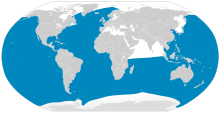Sei whale
| Sei whale | |
|---|---|
 |
|
| Sei whale mother and calf | |
 |
|
| Size compared to an average human | |
| Scientific classification | |
| Kingdom: | Animalia |
| Phylum: | Chordata |
| Class: | Mammalia |
| Order: | Artiodactyla |
| Infraorder: | Cetacea |
| Family: | Balaenopteridae |
| Genus: | Balaenoptera |
| Species: | B. borealis |
| Binomial name | |
|
Balaenoptera borealis Lesson, 1828 |
|
| Subspecies | |
|
|
 |
|
| Sei whale range | |
| Synonyms | |
The sei whale (/ˈseɪ/ or /ˈsaɪ/), Balaenoptera borealis, is a baleen whale, the third-largest rorqual after the blue whale and the fin whale. It inhabits most oceans and adjoining seas, and prefers deep offshore waters. It avoids polar and tropical waters and semienclosed bodies of water. The sei whale migrates annually from cool and subpolar waters in summer to winter in temperate and subtropical waters.
Reaching 19.5 m (64 ft) long and weighing as much as 28 t (28 long tons; 31 short tons), the sei whale consumes an average of 900 kg (2,000 lb) of food every day; its diet consists primarily of copepods, krill, and other zooplankton. It is among the fastest of all cetaceans, and can reach speeds of up to 50 km/h (31 mph) (27 knots) over short distances. The whale's name comes from the Norwegian word for pollock, a fish that appears off the coast of Norway at the same time of the year as the sei whale.
Following large-scale commercial whaling during the late 19th and 20th centuries, when over 255,000 whales were taken, the sei whale is now internationally protected, although limited hunting occurs under a controversial research program conducted by Japan. As of 2008[update], its worldwide population was about 80,000, nearly a third of its prewhaling population.
...
Wikipedia

